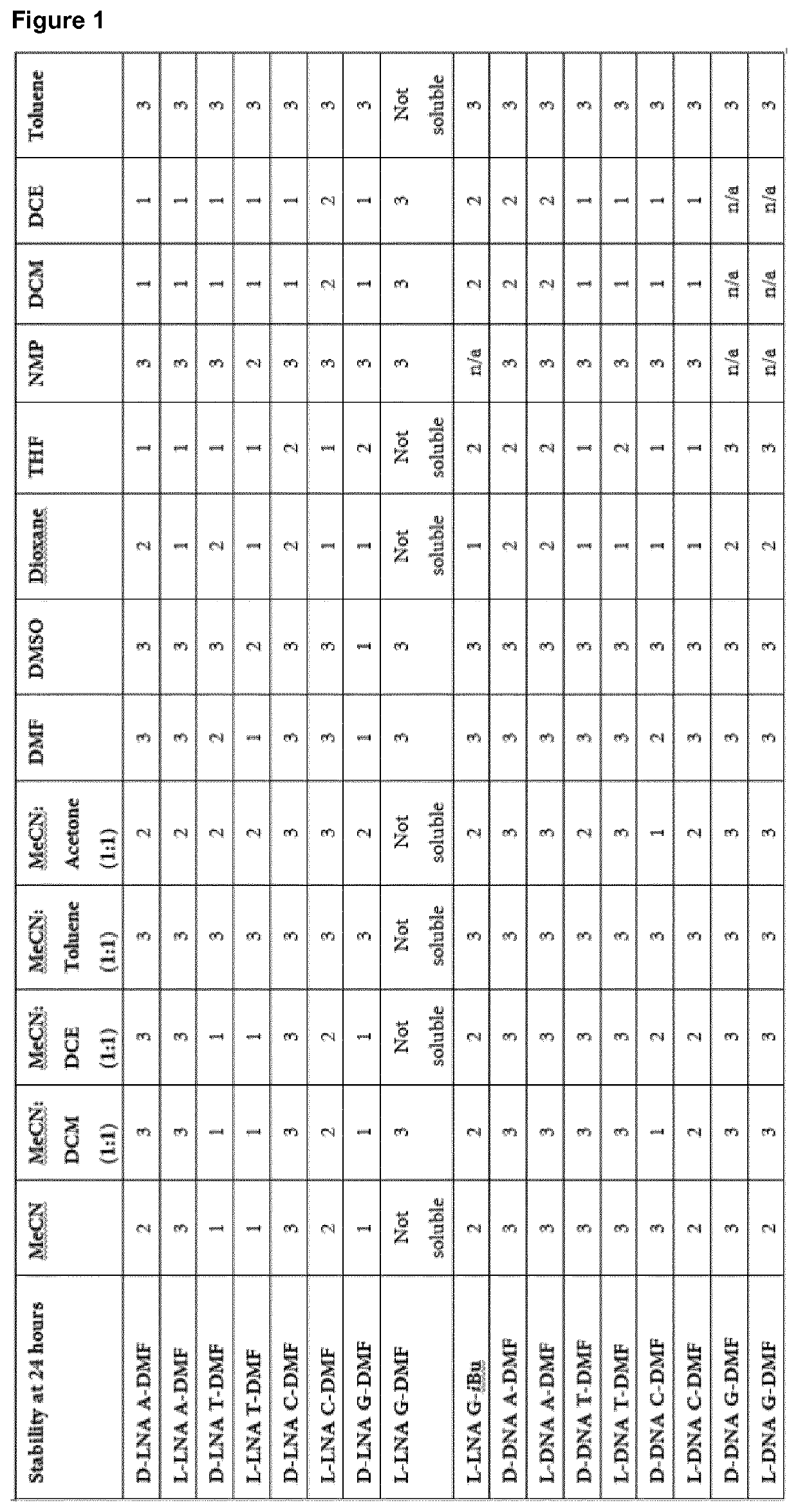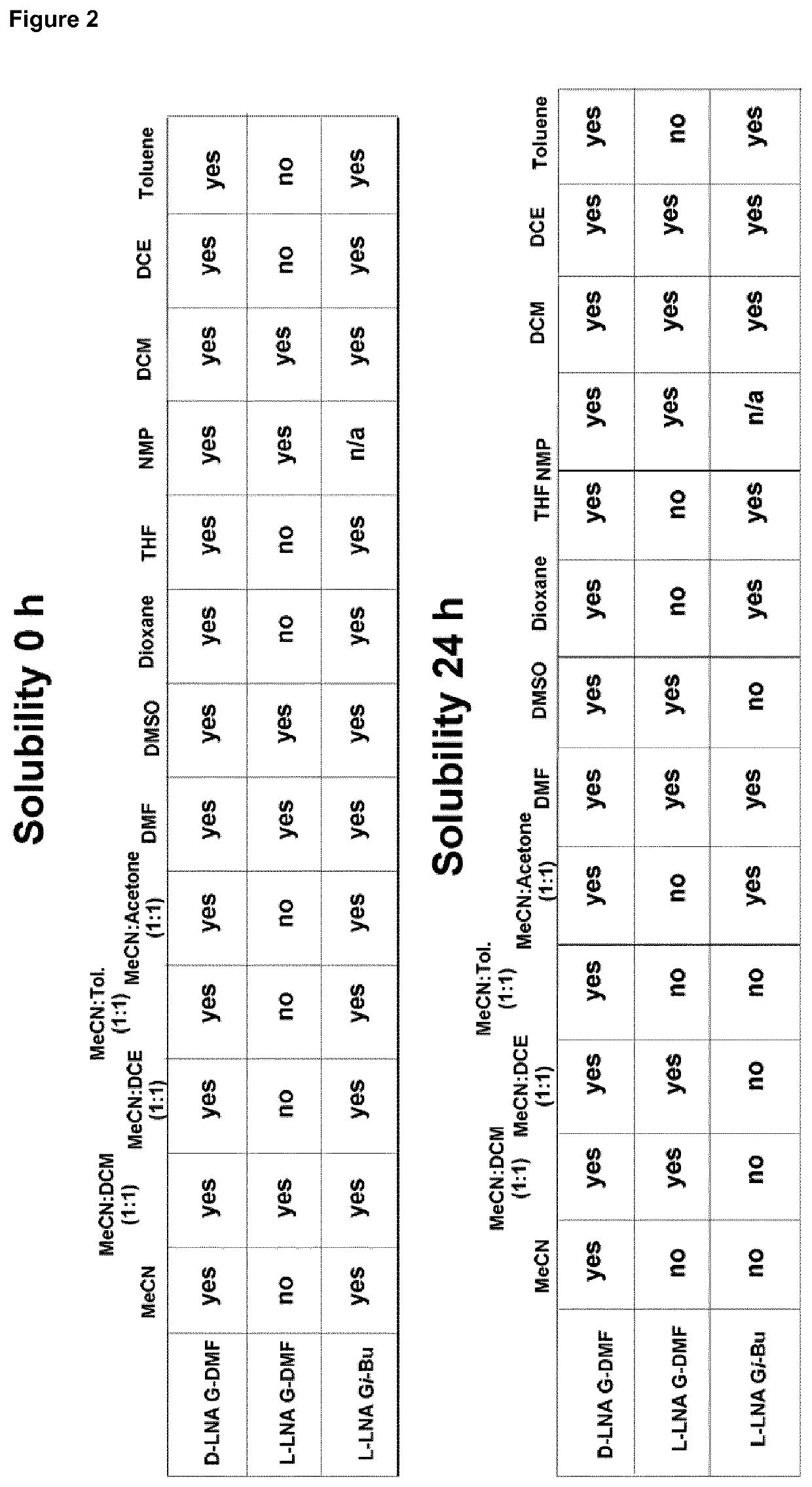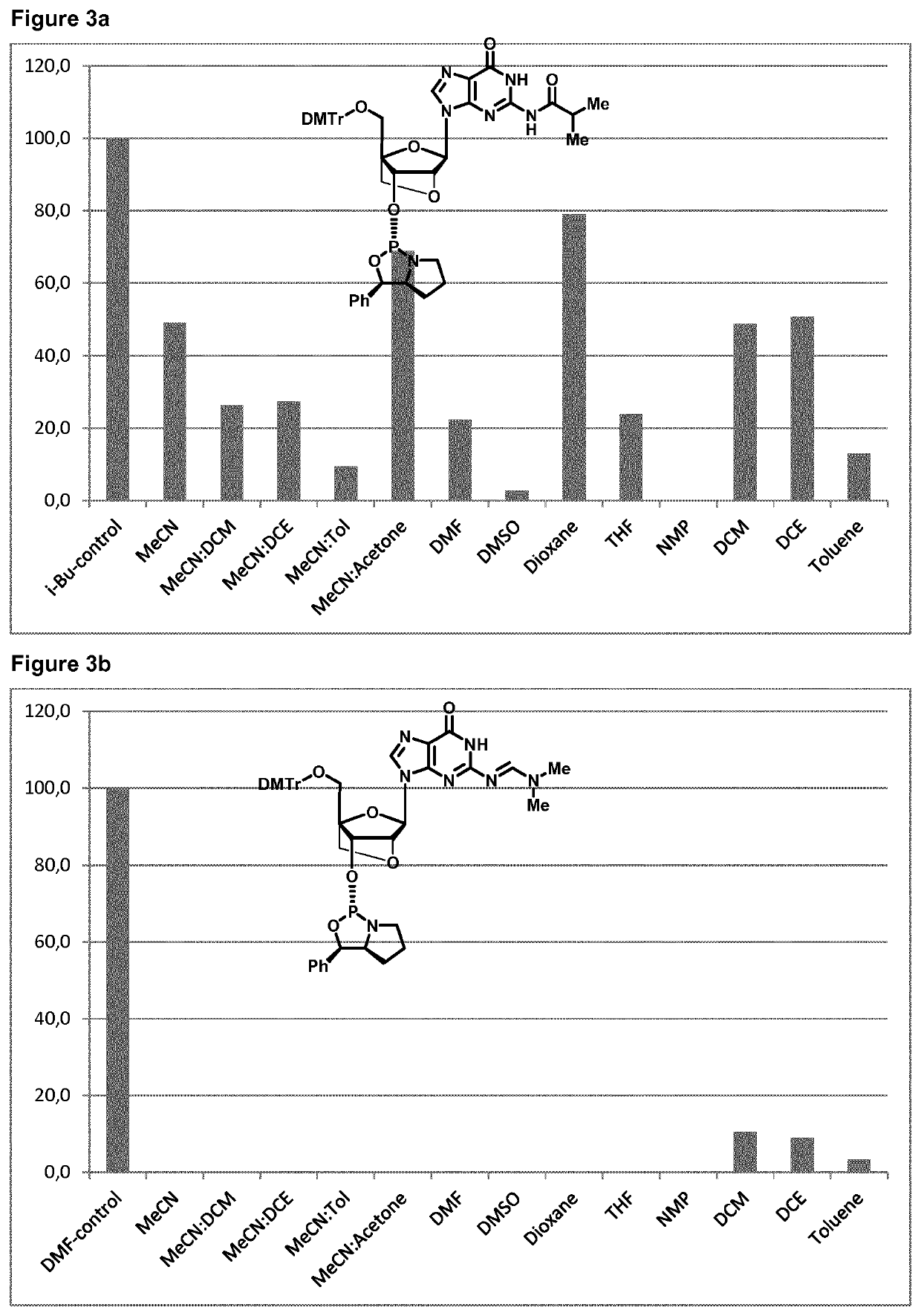Multiple coupling & oxidation method
a phosphorothioate and oligonucleotide technology, applied in the field of multi-coupling oxidation methods, can solve the problems of low lifetime of amidite solutions and blockage of synthesis instruments, and achieve the effect of enhancing oligonucleotide yield and enhancing coupling efficacy
- Summary
- Abstract
- Description
- Claims
- Application Information
AI Technical Summary
Benefits of technology
Problems solved by technology
Method used
Image
Examples
example 1
ynthesis Method
[0403]To a solution of N-methylmorpholine in toluene (50 mL) PCl3 (2.93 mL 33.4 mmol) was added at −70° C. over a time course of 10 min. Hereafter, proline (P5-D or P5-L) auxilary (6.24 g 35.2 mmol) in toluene (50 mL) was added over 30 min (see J. Am. Chem. Soc., 2008, 130, 16031-16037 for synthesis of P5-D and P5-L). The resulting mixture was stirred at room temperature for 1.5 h after which solvent and volatiles were removed in vacuo (40° C. and 15 mbar). Then, the remaining residue was dissolved in THF (50 mL) and hereafter cooled to −70° C. followed by the addition of first NEt3 (17.8 mL 128 mmol) and then, over 30 min, 5′-ODMT-DNA-Nucleoside (16 mmol) as a solution in THF (50 mL). The reaction mixture was stirred at −77° C. for 30 min and then for 2 h at room temperature. Hereafter, cold EtOAc (200 mL) was added and mixture was washed with cold NaHCO3(150 mL), brine (150 mL), dried (Na2SO4), filtered, and evaporated to dryness. The crude product was purified by f...
example 2
Synthesis of D-LNA-G-DMF
[0414]5′-ODMT-LNA-G (3.51 g 5.00 mmol) was co-evaporated with pyridine and then with toluene to remove any residual water or other solvents. Then the residue was dissolved in pyridine (10 mL) and THF (10 mL). This solution was added to solution of D-oxazaphospholidine (3.51 g 5.00 mmol), PCl3 (0.88 mL 10.0 mmol), and NEt3 (3.50 mL 25.0 mmol) at −77° C. The resulting reaction mixture was then stirred at −77° C. for 15 min and then at 1.5 h at room temperature. Hereafter, EtOAc (150 mL) was added and mixture was washed with cold NaHCO3 (100 mL) and brine (100 mL), dried using Na2SO4, filtered, and finally evaporated together with toluene.
[0415]The resulting residue was purified by column chromatography (eluent THF in EtOAc form 10% to 30%+7% NEt3) giving D-LNA-G-DMF (3.91 g, estimated yield 84%).
[0416]1H NMR (400 MHz, DMSO-d6): δ 11.42 (1H, s), 8.56 (1H, s), 7.95 (1H, s), 7.49-7.16 (14H, m), 6.90-6.83 (4H, m), 5.96 (1H, s), 5.58 (1H, d, J=6.7 Hz), 3.87 (1H, d, ...
example 3
Synthesis of L-LNA-G-DMF
[0418]5′-ODMT-LNA-G (4.91 g 7.00 mmol) was co-evaporated with pyridine and then with toluene to remove any residual water or other solvents. Then the residue was dissolved in pyridine (10 mL) and THF (15 mL). This solution was added to solution of L-oxazaphospholidine (2.48 g 14.0 mmol), PCl3 (1.22 mL 14.0 mmol), and NEt3 (4.90 mL 35.0 mmol) at −77° C. The resulting reaction mixture was then stirred at −77° C. for 15 min and then at 1.5 h at room temperature. Hereafter, EtOAc (150 mL) was added and mixture was washed with cold NaHCO3 (100 mL) and brine (100 mL), dried using Na2SO4, filtered, and finally evaporated together with toluene. The resulting residue was purified by column chromatography (eluent THF in EtOAc / DCM 1:1 using a gradient from 15% to 25%+7% NEt3) giving D-LNA-G-DMF (3.41 g, estimated yield 84%). The product was purified by column chromatography as described above.
[0419]1H NMR (400 MHz, DMSO-d6): δ 12.3-11.9 (1H, br s), 11.8-11.5 (1H, br s),...
PUM
| Property | Measurement | Unit |
|---|---|---|
| pKa | aaaaa | aaaaa |
| pKa | aaaaa | aaaaa |
| v/v | aaaaa | aaaaa |
Abstract
Description
Claims
Application Information
 Login to View More
Login to View More - R&D
- Intellectual Property
- Life Sciences
- Materials
- Tech Scout
- Unparalleled Data Quality
- Higher Quality Content
- 60% Fewer Hallucinations
Browse by: Latest US Patents, China's latest patents, Technical Efficacy Thesaurus, Application Domain, Technology Topic, Popular Technical Reports.
© 2025 PatSnap. All rights reserved.Legal|Privacy policy|Modern Slavery Act Transparency Statement|Sitemap|About US| Contact US: help@patsnap.com



